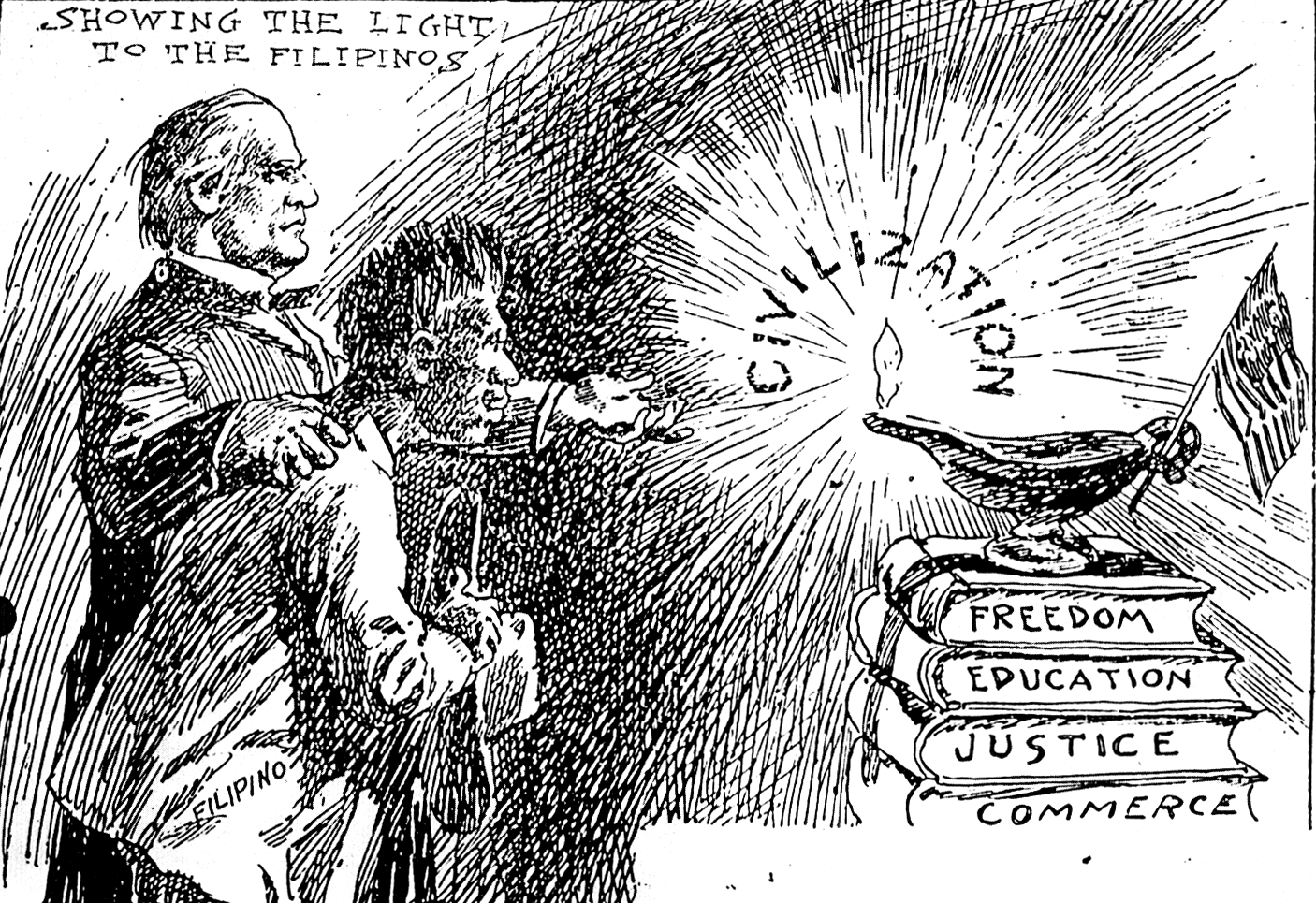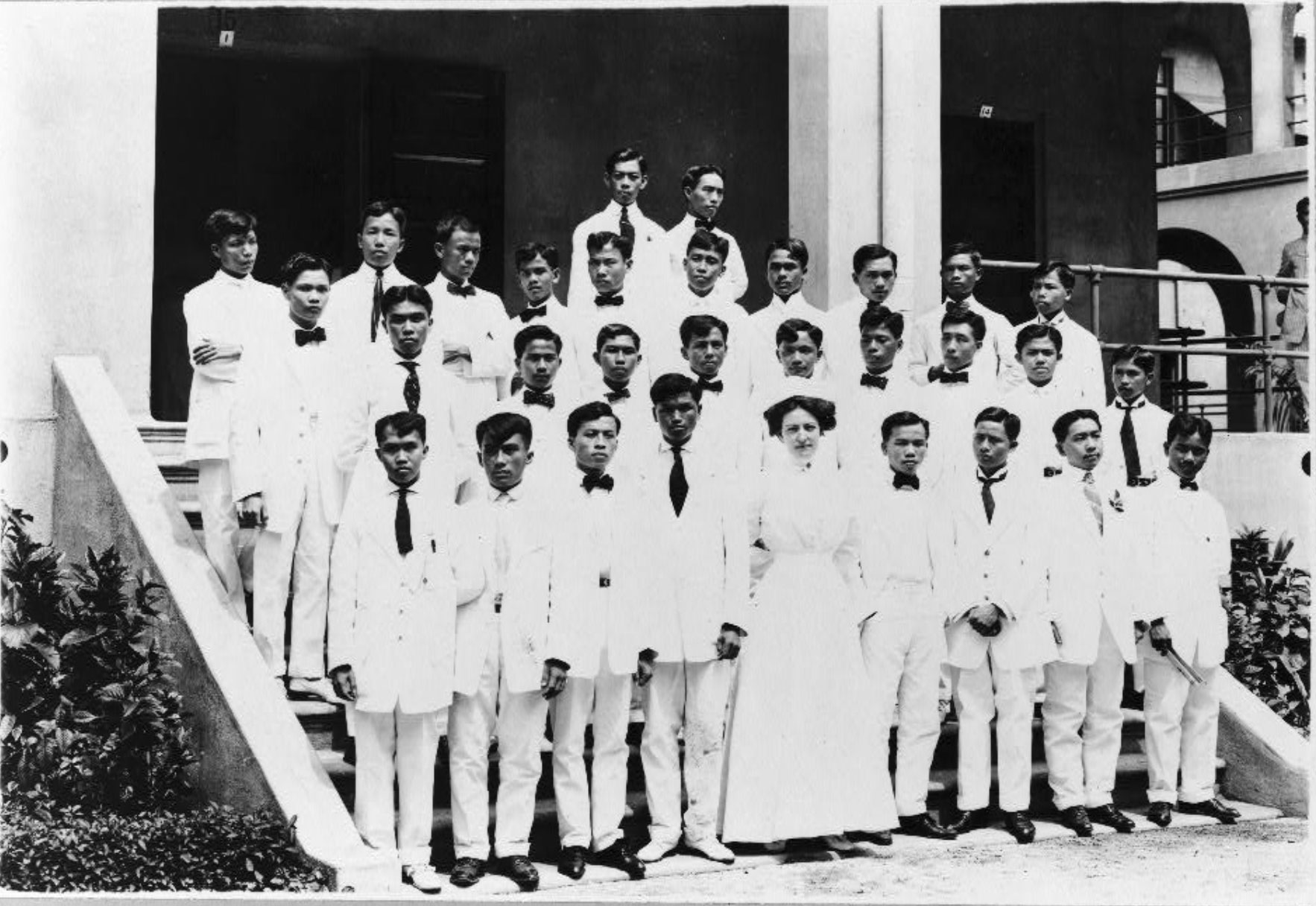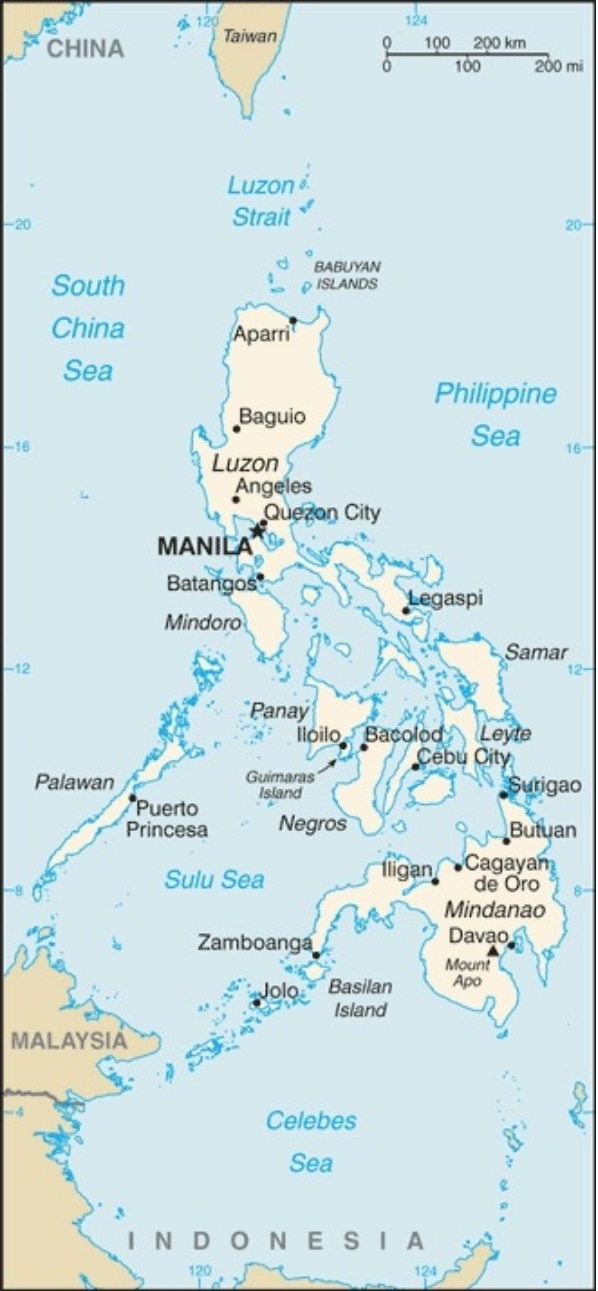Graduating class of student nurses from Philippine General Hospital, taken between 1900-1923.
Credit: Philippine Islands - graduating class of student nurses from Philippine General Hospital, Library of Congress. No known restrictions.
Grade: 6-12Subject:
U.S. History, Social Studies, English Language Arts
Number of Activities: 4
Did you know that about 1 in every 20 registered nurses in the United States is of Filipino ancestry, comprising 4% of the profession?* In California, Filipino Americans make up almost 20% of registered nurses.
In this lesson, students will examine the history of how Filipino American nurses became a prevalent and important force in the U.S healthcare system. Students will analyze the experiences of Filipino American nurses, including instances of discrimination, disparity, and inequality. They will also study the ways in which Filipino American nurses have wielded their advocacy in order to fight for their rights as well as the rights of all healthcare workers in the United States.
*There are some discrepancies in reported statistics. Statistics come from different years and sources. Also, some statistics refer to nurses trained in the Philippines vs. nurses of Filipino ancestry. The most commonly cited statistic is 4%.
Students will:
- Describe the historical factors, perspectives, and motivations that led to an increase in Filipino American nurses.
- Analyze Filipino American nurses’ working conditions, including instances of discrimination in the workplace.
- Identify tactics used by Filipino American nurses to advocate for their rights.
Filipino American Nurses (Secondary) Essay:
Starting in 1898, large numbers of Filipinos entered the healthcare field. More specifically, the number of Filipino
registered nurses significantly increased after the
Spanish-American War (1898). This war was a conflict between the United States and Spain, resulting in the end of Spanish colonial rule (1565-1898), and the U.S. acquisition of Cuba, Guam, Puerto Rico, and the Philippines.
The Philippines, which was newly independent from 333 years of Spanish colonial rule, came under the control of the United States. In 1898, after the Spanish-American War, the Philippines received U.S. national status. The U.S. colonization of the Philippines lasted from 1898 to 1946.
At the start of World War I (1914-1918), and after World War II (1939-1945), the U.S. healthcare system needed workers and faced a nursing shortage. One reason for this shortage was the need for registered nurses to aid in the war efforts. As nurses went to serve in the armed forces abroad, there were fewer nurses at home to care for the civilian population.
To fill these nursing shortages, the United States launched various initiatives. Some of these initiatives specifically targeted Filipinos as a labor source. At the time, the United States imposed
benevolent assimilation on the Philippines. This meant that the United States saw itself as a savior by bringing Western (offensively deemed as “civilized”) culture to the Philippines in order to promote the country’s development. Many historians argue that benevolent assimilation was just another form of colonialism.
The United States established nursing schools in the Philippines based on a U.S.-oriented
curriculum. Their goal was to teach Western medicine and to promote the use of the English language. One example of this was the Union Mission Hospital Training School for Nurses built in 1906. It is the first and oldest running nursing school in the Philippines. It is currently called the Central Philippine University College of Nursing.
In addition, the U.S. Army trained and recruited Filipino nurses to work in hospitals in the Philippines. These hospitals often treated American soldiers and the nurses specialized in treating tropical diseases.
On August 26, 1903, the U.S. Congress passed the
Pensionado Act, which established a scholarship program for Filipinos to attend schools in the United States. Students of the program were called
pensionados. The term pensionado is a Spanish word which can mean a retiree or someone who receives a pension from the government.
Some of the first Filipino nursing students to come to the United States were pensionados. The nurses were
predominantly women. Some pensionados studied in the United States and returned to the Philippines to establish and manage nursing schools. This inspired others to pursue an education in the United States. As U.S nationals, Filipino nurses did not face travel restrictions when coming to the country. Though many nurses returned to the Philippines, others, who were sent to cities such as San Diego, San Francisco, and New York City for training, chose to stay.
In 1965, the
Immigration and Nationality Act was passed by Congress, allowing many skilled workers and family members to come to the United States. Between 1965 and 1988, more than 70,000 foreign nurses entered the United States. The majority of these nurses come from Asia - with the Philippines as the leading source for immigrant registered nurses. It is estimated that at least 25,000 Filipino nurses migrated to the United States from 1965 to 1985.
In the 1980s, the United States faced another nursing shortage. The U.S. healthcare system was rapidly growing and medical technology was advancing. The population was getting older, leading to an increased need in critical care units. Enrollment in U.S. nursing schools was declining. At the same time, the
HIV/AIDS epidemic hit the United States. Due to a lack of knowledge which created biases, many American-born healthcare workers refused to work with AIDS patients. All of these factors led to a demand for more skilled nurses. To address the shortage, the United States recruited nurses from abroad, mostly from the Philippines, as it had in the past.
Today, about 4% of U.S. nurses are from the Philippines or are of Filipino descent. Despite Filipino and Filipino American nurses being a predominant labor force in the healthcare field, they face many barriers in terms of working conditions, language access, and
vulnerability to
fatalities. Filipino American nurses are more likely to work in
acute and long-term
inpatient settings, heightening their risk to exposure to diseases like COVID-19. Filipino American nurses often deal with burnout and frustration in their lack of career advancement, but are less likely to consider leaving their position compared to their White counterparts. Many Filipino American nurses also work in
home health, nursing homes, and
assisted living facilities.
In the 2020s, even though Filipino American nurses only comprised 4% of the registered nurse population, they accounted for over 31% of fatalities among nurses. This was likely due to increased exposure to patients with COVID-19 symptoms, as Filipino American nurses were more likely to work in the most dangerous settings.
Filipino nurses in the United States have faced discrimination, lower pay, and difficult working conditions. They have reported lack of mandated breaks, lack of safety protections, risk of injury on the job, and lack of health insurance. Many Filipino workers in healthcare and caregiving are
migrants, which means they are also susceptible to employer exploitation due to their immigration status.
Filipino nurses have organized to advocate for better treatment. They joined American
union nurses, and eventually became union members and leaders themselves. To promote cultural understanding and advocate for the welfare of nurses, the Philippine Nurses Association was founded in 1928 in New York. It was formerly known as the Filipino Nurses Association (FNA).
In the 1970s-1980s, Filipino nurses worked with KDP activists to form the National Alliance for Fair Licensure of Foreign Nurse Graduates. The KDP (Katipunan ng mga Demokratikong Pilipino, or Union of Democratic Filipinos) was a Filipino American political group active in the 1970s and 1980s who fought for democracy in the Philippines and the rights of Filipino Americans in the United States. The National Alliance for Fair Licensure of Foreign Nurse Graduates sought to resist unfair licensure rules that discriminated against Filipino nurses trained in the Philippines. For example, they argued that some questions on the licensing exam were not culturally sensitive, leading to foreign trained nurses failing at a high rate compared to White nurses trained in the United States. This campaign eventually led to the formation of the SEIU California Nurse Alliance.
In 1989, unions like the 1199SEIU United Healthcare Workers East worked with New York Senator Charles Schumer (born 1950) to pass the Immigration Nursing Relief Act of 1989. This act created a pathway for immigrant nurses to become
permanent residents, and also created the H-1A visa, the first
visa specifically for nurses. Most H-1A visas were issued to Filipino nurses. (The Nursing Relief Act of 1989 expired in 1995, and the last H-1A visas were issued in 2000.)
Zenei Triunfo-Cortez,* a registered nurse, became the first Filipina president of National Nurses United (NNU) in 2018. When Filipino nurses filed a case in 2010 for discrimination, Triunfo-Cortez and the union stood by their side. Additionally, during the COVID-19 pandemic, Triunfo-Cortez and NNU advocated for nurses to receive
personal protective equipment (PPE) and stronger infectious disease guidance. They sent letters and petitions to Congress for the highest levels of protection for healthcare workers.
Along with other organizations such as the National Alliance for Fair Licensure of Foreign Nurse Graduates, and the Foreign Nurse Defense Fund, Filipino and Filipino American nurses fought against exploitative recruiting practices, low wages, and poor working conditions. Filipino nurses are more likely than White nurses to engage in union organizing and
collective bargaining efforts. This is one way in which Filipino nurses have advocated for themselves and advanced the rights of all union-based nurses in the United States.
* Birth year unknown.
Bibliography:
Ceniza Choy, Catherine. (2003). Empire of Care: Nursing and Migration in Filipino American History. Duke University Press Books.
Garbes, A. (2022). Essential Labor: Mothering as Social Change. Harper.
Nazareno, Jennifer, Emily Yoshioka, Alexander C. Adia, Arjee Restar, Don Operario, & Catherine Ceniza Choy. From imperialism to inpatient care: Work differences of Filipino and White registered nurses in the United States and implications for COVID‐19 through an intersectional lens.
Gender, Work & Organization. 2021 Jul;28(4):1426-1446.
https://www.ncbi.nlm.nih.gov/pmc/articles/PMC8251240/
- Acute care: a level of healthcare in which the patient is treated for a brief, but severe injury or illness; an urgent medical condition; or recovery from surgery
- Assisted living: a facility that houses people with disabilities and/or people who cannot live independently
- Benevolent assimilation: a U.S. policy used to govern the Philippines after the 1898 Spanish-American War suggesting that the United States was saving or civilizing the Philippines
- Collective bargaining: negotiation between an employer and a labor union usually on wages, hours, and working conditions
- Curriculum: courses offered by an educational institution, like a school or university
- Fatality: a death caused by accident, violence, or disease
- HIV/AIDS: Acquired immunodeficiency syndrome (AIDS) occurs at the most advanced stage of an Human immunodeficiency virus (HIV) infection; HIV is a virus that attacks the body’s immune system
- Home health: also known as homecare, this is healthcare provided in an individual’s home for illness or injury
- Immigration and Nationality Act of 1965: (also known as the Hart-Celler Act) a law that changed immigration policy by allowing many skilled workers and family members of U.S. citizens to come to the United States
- Inpatient setting: a hospital or facility where a patient is admitted and stays overnight (or multiple nights) to receive medical care
- Migrant: a person who moves away from their home (temporarily or permanently)
- Pensionado: a Filipino student studying in the United States under the Pensionado Act
- Pensionado Act: a law passed in 1903 that established a scholarship program for Filipinos to attend school in the United States
- Permanent resident: a person who is legally allowed to live and work in the United States permanently
- Personal Protective Equipment (PPE): equipment worn to reduce the risk of exposure to hazards in the workplace, like gloves and masks
- Predominant: having the most influence or being the most frequent/common
- Registered Nurse (or RN): a certified healthcare worker who provides patient care and works closely with a doctor
- Spanish-American War (1898): a conflict between the United States and Spain resulting in the end of Spanish colonial rule, and the U.S acquisition of Cuba, Guam, Puerto Rico, and the Philippines
- Union: an organization of workers formed for the purpose of advancing its members’ interests in respect to wages, benefits, and working conditions
- Visa: an official authorization that says a document has been examined and the person holding the visa may proceed
- Vulnerability: being susceptible to being hurt or damaged
- What are the impacts of the Spanish-American War on the nursing population in the United States?
- What is benevolent assimilation? How did it affect Filipinos?
- What was the significance of laws such as the Pensionado Act, and the Immigration and Nationality Act of 1965, on Filipino immigration and the nursing profession?
- What are some challenges faced by Filipino and Filipino American nurses today? Why do these challenges exist?
- How did Filipino nurses advocate for change in their workplace?
- What factors and events facilitated the migration of Filipino nurses to the United States?
- How did their presence shape nursing and healthcare in the United States?
The Philippines is an archipelago, which is a group of islands. In the Philippines, there are over 7,000 islands.
Credit: CIA The World Factbook (Public Domain)
Activity 1: Examining the Experiences of Filipino American Nurses
- Have students read the essay. Consider the following options:
- OPTION 1: Have students read the essay independently either for homework or during class time.
- OPTION 2: Read aloud the essay and model annotating.
- OPTION 3: Have students read aloud in pairs or small groups.
- Facilitate a class discussion by asking the Discussion Questions.
- Have students watch the video entitled, “Why the US has so many Filipino nurses.”
- Have students complete the worksheet entitled, “Filipino American Nurses: Video and Note Catcher.” Have students answer the following questions:
- How did the recruitment of Filipino nurses to the United States impact the U.S. healthcare system?
- How did the recruitment of Filipino nurses to the United States impact the nursing profession in the Philippines?
- What are some challenges and successes Filipino nurses faced as they worked in American hospitals?
- In what ways have Filipino nurses organized and advocated for their rights and recognition?
- Facilitate a class discussion by reviewing students’ responses to the questions above.
- Have students watch the trailer for the documentary, “Nurse Unseen.” Ask students: “What did you learn from this video?”
- Create and display the following chart for all to see:
|
|
Problem
|
Solution
|
|
United States
|
|
|
|
The Philippines
|
|
|
|
Fil-Am Nurses
|
|
|
- Have students complete the chart by having them identify the problems and solutions of the United States, the Philippines, and Filipino American (Fil-Am) nurses in regard to nursing.
- Facilitate a discussion by asking the following questions:
- What are the similarities between the perspectives and motivations of the United States, the Philippines, and Filipino American nurses?
- What are the differences between the perspectives and motivations of the United States, the Philippines, and Filipino American nurses? What accounts for these differences?

This cartoon, published in the Boston Herald in March 1899, shows the belief that the United States saw itself as a savior who was “civilizing” the Philippines by bringing Western culture to the Philippines.
Activity 2: Analyzing Sources
Activity 3: Conducting an Oral History
- Show students the trailer for the documentary, “Nurse Unseen,” again. Ask students the following questions:
- What stories were presented in the video?
- Why is storytelling important?
- Why is storytelling relevant in regard to healthcare workers and their experiences?
- What do we get from stories that we don’t get from other resources?
- Show students the video entitled, “Oral History at Home.” (Teach the lesson if needed.) Ask students the following questions:
- What is oral history?
- What are the five easy steps for conducting an oral history at home?
- Have students conduct an oral history project where they interview Filipino American nurses.
- Have students identify who they would like to interview.
- Have students plan out their interview structure and questions.
- Have students describe their ethic of care. Have students read and review the following guide for further support.
- Have students conduct their interviews and record them (through video or audio).
- Have students write an essay summarizing what they learned.
- Host a listening session where students hear other oral histories made by their classmates. Facilitate a discussion by asking the following questions:
- What were some of your initial thoughts and feelings after listening to these interviews?
- How is learning from an oral history different from learning from a text?
- What were similar experiences across the oral histories?
- What were some differences across the oral histories and what accounts for those differences?
- What types of challenges did these nurses face and how did they overcome them?
- What was surprising to you?
Activity 4: Researching Organizing Efforts of Filipino American Nurses
- Tell students the following: “One way that Filipino American nurses have fought for their rights and the rights of all healthcare workers in the United States is through organizing.”
- Have students share examples from the essay of how Filipino American nurses have organized to increase their rights and/or improve working conditions. Have students complete a T-chart listing the organization in the left column and their actions and achievements in the right column.
- Distribute the worksheet entitled, “Researching Organizing Efforts of Filipino American Nurses.”
- Have students choose one of the examples below of Filipino American nurses’ organizing efforts. (Allow students the option to suggest other examples.)
- Philippine Nurses Association
- National Alliance for Fair Licensure of Foreign Nurse Graduates
- SEIU California Nurse Alliance
- 1199SEIU United Healthcare Workers East
- National Nurses United
- Foreign Nurse Defense Fund
- Have students research the example and complete the worksheet:
- Have students list the name of the organization in the top row.
- Have students list the organization’s years active in the second row.
- Have students write a brief history of the organization in the third row.
- Have students list key Filipino American leaders in the fourth row.
- Have students describe problem(s) addressed by the organization in the fifth row.
- Have students describe challenges faced by the organization in the sixth row.
- Have students describe successes and accomplishments of the organization in the seventh row.
- Have students create a recruitment brochure or poster of the group.
- Have students include the group’s name and motto.
- Have students include benefits of joining the group.
- Have students include the achievements of the group.
- Have students work with other students who studied the same group. Have them create a pitch to present to the rest of the class.
- Facilitate a discussion using the following questions:
- What similarities were there among the examples of Filipino American nurses’ organizing efforts? What accounts for these similarities?
- What differences were there among the examples of Filipino American nurses’ organizing efforts? What accounts for these differences?
- How have Filipino American nurses’ advocacy and organizing benefited all healthcare workers?
- How have these efforts benefited patients?
- Why is organizing important?
- Have students read the article entitled, “Resilience and Community: Filipino Americans, Nursing, and COVID-19.” Facilitate a class discussion by asking the following questions: What does resilience mean to you? Why do communities need to be resilient in order to be successful or thrive? What are some setbacks to having to be constantly resilient?
-
Have students read the article, “Meet the Bay Area rapper working on a COVID vaccine.” Have students listen to some of Ruby Ibarra’s songs and analyze them for themes of immigration and Filipino identity.
- Have students listen to the podcast episode of Unsung History called “Filipino Nurses in the United States” featuring Dr. Catherine Ceniza Choy. Have students record a short podcast with a partner in response to the question from the podcast episode’s description: Why are there so many Filipino nurses in the United States and especially so many on the frontlines of healthcare?
- Invite a guest speaker from the Philippine Nurses Association or another advocacy group to talk to your students.
- Have students engage in a debate to answer the following question: Is the U.S. involvement in the development and recruitment of Filipino nurses more helpful or harmful?
- Have students use the materials they created in Activity 4 on Filipino American nurses’ organizing efforts. Have them imagine they are at a healthcare conference and set up a table/exhibit for the organization they are representing. Have students prepare materials to share information about their organization (i.e. flyers, brochures, posters, bookmarks, etc.) to educate and inform others about their cause and potentially recruit new members. Have students prepare a one-minute pitch about the organization. Invite another class to come to the conference and “network” with each group.
D2.His.4.6-8.
Analyze multiple factors that influenced the perspectives of people during different historical eras.
D2.His.9.6-8.
Classify the kinds of historical sources used in a secondary interpretation.
D2.His.14.6-8.
Explain multiple causes and effects of events and developments in the past.
D2.His.4.9-12.
Analyze complex and interacting factors that influenced the perspectives of people during different historical eras.
D2.His.5.9-12.
Analyze how historical contexts shaped and continue to shape people’s perspectives.
D2.His.14.9-12.
Analyze multiple and complex causes and effects of events in the past.
CCSS.ELA-Literacy.RH.6-8.2
Determine the central ideas or information of a primary or secondary source; provide an accurate summary of the source distinct from prior knowledge or opinions.
CCSS.ELA-Literacy.RH.6-8.6
Identify aspects of a text that reveal an author's point of view or purpose (e.g., loaded language, inclusion or avoidance of particular facts).
CCSS.ELA-Literacy.RH.6-8.7
Integrate visual information (e.g., in charts, graphs, photographs, videos, or maps) with other information in print and digital texts.
CCSS.ELA-Literacy.RH.9-10.1
Cite specific textual evidence to support analysis of primary and secondary sources, attending to such features as the date and origin of the information.
CCSS.ELA-Literacy.RH.9-10.2
Determine the central ideas or information of a primary or secondary source; provide an accurate summary of how key events or ideas develop over the course of the text.
CCSS.ELA-Literacy.RH.9-10.7
Integrate quantitative or technical analysis (e.g., charts, research data) with qualitative analysis in print or digital text.
CCSS.ELA-Literacy.RH.11-12.2
Determine the central ideas or information of a primary or secondary source; provide an accurate summary that makes clear the relationships among the key details and ideas.
CCSS.ELA-Literacy.RH.11-12.7
Integrate and evaluate multiple sources of information presented in diverse formats and media (e.g., visually, quantitatively, as well as in words) in order to address a question or solve a problem.
CCSS.ELA-Literacy.RH.11-12.9
Integrate information from diverse sources, both primary and secondary, into a coherent understanding of an idea or event, noting discrepancies among sources.




